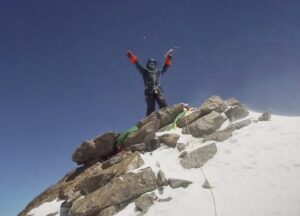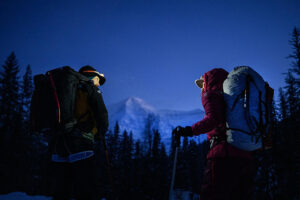Last spring, three climbers from the New Zealand Alpine Team made a first repeat of the legendary 1976 Tasker-Boardman route on the West Face of 6,864m Changabang, in the Garhwal Himalaya.

The North Face of Changabang. The British West Ridge route cuts into the sky in the centre right. Photo: New Zealand Alpine Team
Australians Matthew Scholes and Kim Ladiges, and New Zealander Daniel Joll topped out on May 2, 2022, at 11 am, in a single alpine-style push from Base Camp.

The 1976 route up the West Face of Changabang. Illustration: Pete Boardman
In the footsteps of Boardman and Tasker
“We’d all read The Shining Mountain [Pete Boardman’s book after their 1976 ascent], and it inspired us to come to the area and to follow in the footsteps of Boardman and Tasker”, said Daniel Joll after the climb, in an interview with Dream Wanderlust.
Since Boardman and Tasker’s epic climb, 20 different expeditions had unsuccessfully tried to re-do the route.
Then on May 7, 2022, the New Zealand Alpine Team posted briefly but momentously on social media: “In 1976, Pete Boardman and Joe Tasker climbed the West Ridge of Changabang. Their ascent was considered the hardest high-altitude alpine climb in the world at the time [and has been] unrepeated for the last 46 years. Changabang has not seen a successful ascent and return to Base Camp in over 24 years. Both those facts changed last week.”

Hauling bags up to the col. Photo: New Zealand Alpine Team
The climb
The team acclimatized directly on the route. Sometimes they moved just 200m to 300m up the wall before stopping. There were no good bivy spots, so the three climbers took two portaledges, designed by renowned big-wall climber John Middendorf.
The route goes up the 1,600m granite West Face of Changabang. Some sections required big-wall climbing techniques.
After hauling all their gear up the glacier to the base of the West Face over seven tiring days, the three set off from Advanced Base Camp on April 25, 2022, at 2:45 am. They stopped at 5,950m on the West Ridge for the night, then continued.

On the West Ridge. Photo: New Zealand Alpine Team
“I have always believed the right pairing of climbing partners on the right day is potentially unstoppable on a mountain,” wrote Joll after their climb. They trained for more than two years for the expedition.
The three climbers took turns leading one day each, and it was paramount for each not to fail the others on their allotted day.
“This placed a lot of pressure on you when your turn came around, but it also acted as a great motivator, as you knew the others had suffered equally,” recalled Joll.
They had to fight against daily afternoon storms. “Moments of warmth and pleasure were few and far between,” Joll admitted.

Left The Boardman-Tasker route, in red. Right, the Scholes-Ladiges-Joll route in black. Photo: Bigwalls.net/New Zealand Alpine Team
Indeed, the low temperatures, difficult terrain, and altitude were not easy to deal with. Some sources say that Boardman and Tasker prepared for some of their expeditions by spending time in a meat factory freezer.
During the ascent, Joll, Ladiges, and Scholes made a small variation of the original Boardman-Tasker route and opened some 20 pitches of entirely unclimbed terrain.

The last bivouac before the summit. Photo: New Zealand Alpine Team
The summit
They did not want to think ahead too much during the painstakingly slow ascent.
“The only way to cope was to focus on one day at a time,” recalled Joll. “None of us thought we would summit. We never imagined it could be possible until the final one hundred metres.
“The route remained steep and sustained right to the final pitch. I followed the last lead side by side with Kim. I could feel the emotion and tension of the last weeks and months starting to well up. On the summit, the three of us embraced, [and] tears flowed freely.”
After summiting, they had to rush down, as a storm was approaching. The team finally reached the Advanced Base Camp the following day, May 3, at 7 pm.

The three climbers on the summit of Changabang. Photo: New Zealand Alpine Team
Climbing history
Changabang lies in India’s Garhwal Himalaya. Although the peak does not have significant prominence — it’s even lower than its neighboring mountains — it’s a steep and rocky peak. All routes on it, done or undone, are very difficult.
Eric Shipton, Tom Longstaff, and Bill Tillman saw Changabang early in its climbing history. Longstaff, who visited the Garhwal Himalaya in 1927, called it “the most superbly beautiful mountain I’ve ever seen”.

Changabang and its neighbors. Photo: Caingram
The first ascent of Changabang
It was first climbed on June 4, 1974, by Tashi Chewang, Balwant Singh Sandhu, Chris Bonington, Dougal Haston, Marton Boysen, and Doug Scott, via the Southeast Face-East Ridge.
“Rucksack and crampons off, we crawl onto a pile of mail, our first in a month,” wrote Balwant Singh Sandhu for The Himalayan Club after the expedition. “Letters from wives, children, and friends. Ten of us have climbed a mountain and in no small measure have surmounted our personal vanities.”

Changabang from near Advanced Base Camp in 1974, during the first ascent of the peak. Photo: The Himalayan Club
Other outstanding ascents on Changabang
In 1976, a strong party from the Japanese Alpine Club climbed Changabang by its Southwest Ridge. Naoki Toda, Akira Kobayashi, Masahide Aida, Harumi Ohno, Yukio Asano, and Teruyoshi Karino summited after 33 hard-fought days.
Two years later, in 1978, Wojciech Kurtyka, Krzysztof Zurek, Alex MacIntyre, and John Porter climbed the peak via a direct route on the South Face.
In 1981, Italians Ugo Manera and Lino Castiglia ascended the South Ridge route.
Andy Cave and Brendan Murphy made the first ascent of the North Face in 1997, along a 1,600m line. Unfortunately, Murphy died during the descent when he was hit by an avalanche and swept off the face.

One member of the Groupe militaire de haute montagne climbs toward the headwall on the North Face of Changabang in 2018. Leo Billon, Sebastien Moatti, and Sebastien Ratel managed to reach the Changabang Horn, a small peak just north of the main summit. Photo: GMHM
Why this climb is important
We tend to think that a first ascent or a new route on a difficult peak is the most important challenge. However, there is another worthy goal. Those who first ascended an “impossible” route in perfect style wrote their names in the history of alpinism. Re-doing their route is a way to honor those pioneers. It also helps keep the spirit of mountaineering alive.
As the French philosopher Bernand of Chartres famously said in the 12th century:
“We’re like dwarfs sitting on the shoulders of giants in order to see more things than they did and to see farther, not because our vision is sharper or our stature is greater, but because we can rise higher, thanks to their giant stature.”

Joe Tasker and Peter Boardman. Both died on Everest’s Northeast Ridge in 1982. Photo: Pete Boardman






